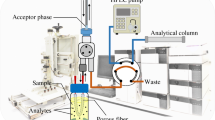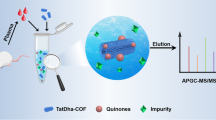Abstract
Hollow fiber cell fishing with high-performance liquid chromatography (HFCF-HPLC) based on human breast cancer MCF-7 cells, human renal tubular ACHN cells, human ovarian cancer SKOV-3 cells, and hepatoma HepG-2 cells, and their cell membranes, cell organelles, or receptors was developed and employed to research the active matrine alkaloids group, such as oxymatrine, matrine, sophoridine, and oxysophocarpine, from radix sophorae flavescentis (RSF) and its injection in vitro. Hollow fiber liquid-phase microextraction with HPLC (HF-LPME-HPLC) was conducted to extract and detect the active components in vivo. Some of the structures of the active components screened were identified in vitro. The binding sites and targets of the potential active matrine compounds were preliminarily researched. The effective anti-cancer components were determined, and the efficacy material basis of both medicines on matrine alkaloids was elucidated. Before the application of HFCF-HPLC, the survival rate of cells seeded on the fiber, death rate after screening components, non-specific binding between active centers on the fiber and target components, positive and negative controls, and repeatability of the tests were investigated. Results demonstrated that HFCF-HPLC, coupled with HF-LPME-HPLC, is a simple, quick, and reliable method to screen active components, determine truly effective components, and elucidate preliminarily the characteristics of multiple components and multiple targets for traditional Chinese medicine.






Similar content being viewed by others
References
Chai NL, Fu Q, Shi H, Cai CH, Wan J, Xu SP, Wu BY (2012) Oxymatrine liposome attenuates hepatic fibrosis via targeting hepatic stellate cells. World J Gastroenterol 18:4199–4206
Li X, Chu W, Liu J, Xue X, Lu Y, Shan H, Yang B (2009) Antiarrhythmic properties of long-term treatment with matrine in arrhythmic rat induced by coronary ligation. Biol Pharm Bull 32:1521–1526
Liu Y, Xu Y, Ji W, Li X, Sun B, Gao Q, Su C (2014) Anti-cancer activities of matrine and oxymatrine: literature review. Tumour Biol 35:5111–5119
Jiang H, Hou C, Zhang S, Xie H, Zhou W, Jin Q, Cheng X, Qian R, Zhang X (2007) Matrine upregulates the cell cycle protein E2F-1 and triggers apoptosis via the mitochondrial pathway in K562 cells. Eur J Pharmacol 559:98–108
Jin JH, Kim JS, Kang SS, Son KH, Chang HW, Kim HP (2010) Anti-inflammatory and anti-arthritic activity of total flavonoids of the roots of Sophora flavescens. J Ethnopharmacol 127:589–595
Sun HL, Li L, Shang L, Zhao D, Dong DL, Qiao GF, Liu Y, Chu WF, Yang BF (2008) Cardioprotective effects and underlying mechanisms of oxymatrine against ischemic myocardial injuries of rats. Phytother Res 22:985–989
Zhang Y, Dong Z, Jin L, Zhang K, Zhao X, Fu J, Gong Y, Sun M, Yang B, Li B (2013) Arsenic trioxide-induced hERG K + channel deficiency can be rescued by matrine and oxymatrine through up-regulating transcription factor Sp1 expression. Biochem Pharmacol 85:59–68
Yao W, Sun PH, Xu XM, Li YJ, Yuan CS, Wang ZH (2014) Alkaloids constituents of Sophora alopecuroides seed and their cytotoxic activity. Chin J Exp Tradit Med Formulae 20:95–99
Dai WH, Qian LW, Yang SY, Zhou GQ, Wang LL (2012) Study on antimicrobial activity of alkaloids in Sophora flavescens and S. tonkinensis. Chin J Exp Tradit Med Formulae 18:177–180
Huang XM, Li B, Shen LZ, Wang JY (2001) Inhibitory effects of four alkaloids of Sophora alopecuroides on TNFα production by murine peritoneal macrophages. Pharmacol Clin Chin Mater Med 17:11–14
Wang Y, Yuan B, Deng X, He L, Wang S, Zhang Y, Han Q (2006) Comparison of alpha1-adrenergic receptor cell-membrane stationary phases prepared from expressed cell line and from rabbit hepatocytes. Anal Bioanal Chem 386:2003–2011
Guo Y, Han S, Cao J, Zhang T, He L (2014) Histamine H1 receptor cell membrane chromatography online high-performance liquid chromatography with mass spectrometry method reveals houttuyfonate as an activator of the histamine H1 receptor. J Sep Sci 37:3188–3194
Dong QQ, Li P, Wen XD (2007) Constituents of Salviae Miltiorrhizae absorbed by Caco-2 Cell. Chin J Nat Med 5:59–62
Zhang HY, Hu CX, Liu CP, Li HF, Wang JS, Yuan KL, Tang JW, Xu GW (2007) Screening and analysis of bioactive compounds in traditional Chinese medicines using cell extract and gas chromatography-mass spectrometry. J Pharm Biomed Anal 43:151–157
Zheng ZG, Duan TT, He B, Tang D, Jia XB, Wang RS, Zhu JX, Xu YH, Zhu Q, Feng L (2013) Macrophage biospecific extraction and HPLC–ESI-MS analysis for screening immunological active components in Smilacis Glabrae Rhizoma. J Pharm Biomed Anal 77:44–48
Zhou J, Sun JB, Zheng P, Liu J, Cheng ZH, Zeng P, Wang FQ (2012) Orthogonal array design for optimization of hollow-fiber-based liquid-phase microextraction combined with high-performance liquid chromatography for study of the pharmacokinetics of magnoflorine in rat plasma. Anal Bioanal Chem 403:1951–1960
Liang M, Zhang WW, Meng PJ, Zhu BL, Zheng KF (2015) Comparison of hollow fiber liquid-phase microextraction and ultrasound-assisted low-density solvent dispersive liquid-liquid microextraction for the determination of drugs of abuse in biological samples by gas chromatography-mass spectrometry. J Chromatogr B 989:46–53
Wang J, Hu S, Bai XH (2010) Determination of trace amounts of chlorogenic acid and three of its metabolites using time-resolved LPME and LC-UV detection in biological specimens. Chromatographia 72:453–458
Yan YY, Chen X, Hu S, Bai XH (2014) Applications of liquid-phase microextraction techniques in natural product analysis: a review. J Chromatogr A 1368:1–17
Hadjmohammadi M, Karimiyan H, Sharifi V (2013) Hollow fibre-based liquid phase microextraction combined with high-performance liquid chromatography for the analysis of flavonoids in Echinophora platyloba DC. and Mentha piperita. Food Chem 141:731–735
Xue X, Li LH, Chen X, Hu S, Bai XH (2013) Hollow fiber cell fishing with high performance liquid chromatography for screening bioactive compounds from traditional Chinese medicines. J Chromatogr A 1280:75–83
Yan YY, Hao YM, Hu S, Chen X, Bai XH (2013) Hollow fiber cell fishing with high performance liquid chromatography for screening bioactive anthraquinones from traditional Chinese medicines. J Chromatogr A 1322:8–17
Liu X, Hu S, Chen X, Bai XH (2014) Hollow fiber cell fishing with high-performance liquid chromatography for rapid screening and analysis of an antitumor-active protoberberine alkaloid group from Coptis chinensis. J Pharm Biomed Anal 98:463–475
Zhang LS, Chen X, Hu S, Sheng X, Bai XH (2014) Rapid screening of different types of antitumor compound groups from Traditional Chinese Medicine by hollow fiber cell fishing with high performance liquid chromatography. Comb Chem High Throughput Screen 17:827–836
Li S, Chen X, Hu S, Yan HH, Bai XH (2015) Screening of bioactive compounds and research of possible targets based on hollow fiber cell fishing with high performance liquid chromatography. Anal Methods 7:3124–3133
Zhang LP, Ding H, Xie Y, Guo XL (2009) High performance liquid chromatography determination of tamoxifen citrate gel content. Chin Remedies Clin 9:716–717
Zhuang LB (2013) High performance liquid chromatography (HPLC) method for determining the content of indomethacin tablets. J Med Theor Prac 26:2497–2498
He S, Shen W, Shen DM (2003) Taxol shows cytotoxic activity in hepatoma cell line HepG-2 in vitro. Chongqing Med 3:268–270
Mastrandrea N, Cai WL, Tham KY, Monks TJ, Lau SS (2013) PP117-The varying effects of pentoxifylline on cyclin D1 levels and G1 phase arrest in different renal cell carcinoma cell models. Clin Ther 3:e51
Liu CY, Hung MH, Wang DS, Chu PY, Su JC, Teng TH, Huang CT, Chao TT, Wang CY, Shiau CW, Tseng LM, Chen KF (2014) Tamoxifen induces apoptosis through cancerous inhibitor of protein phosphatase 2A-dependent phospho-Akt inactivation in estrogen receptor-negative human breast cancer cells. Breast Cancer Res 16:431
Ishihara Y, Itoh K, Ishida A, Yamazaki T (2014) Selective estrogen-receptor modulators suppress microglial activation and neuronal cell death via an estrogen receptor-dependent pathway. J Steroid Biochem Mol Biol 145:85–93
Wang HM, Zhang GY (2004) Experimental study of the inhibitory effect of indomethacin on the growth and angiogenesis of human colon cancer xenografts. J First Mil Med Univ 24:184–187
Wang YX, Gao JX, Wang XY, Zhang L, Liu CM (2012) Antiproliferative effects of selective cyclooxygenase-2 inhibitor modulated by nimotuzumab in estrogen-dependent breast cancer cells. Tumor Biol 33:957–966
Liu J, He C, Zhou K, Wang J, Kang JX (2009) Coptis extracts enhance the anticancer effect of estrogen receptor antagonists on human breast cancer cells. Biochem Biophys Res Commun 378:174–178
Acknowledgments
This study was supported by the National Nature Science Foundation of China (No. 81302734) and the Nature Science Foundation of Shanxi Province, China (No. 2011011035-2, 2012011007-4).
Author information
Authors and Affiliations
Corresponding authors
Rights and permissions
About this article
Cite this article
Zhang, R., Hu, S., Chen, X. et al. Screening and Research of Anti-Cancer Matrine Components Based on Hollow Fiber Cell Fishing with High-Performance Liquid Chromatography. Chromatographia 79, 125–136 (2016). https://doi.org/10.1007/s10337-015-3006-8
Received:
Revised:
Accepted:
Published:
Issue Date:
DOI: https://doi.org/10.1007/s10337-015-3006-8




